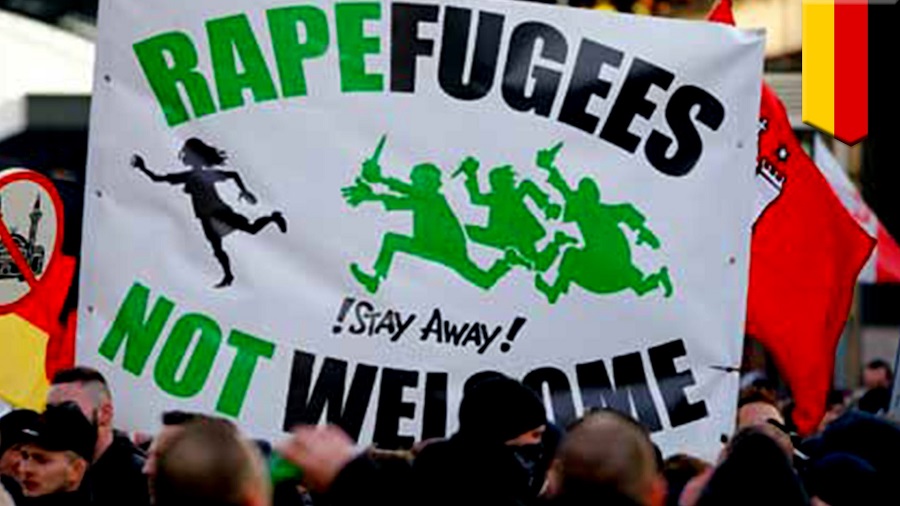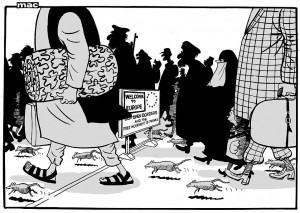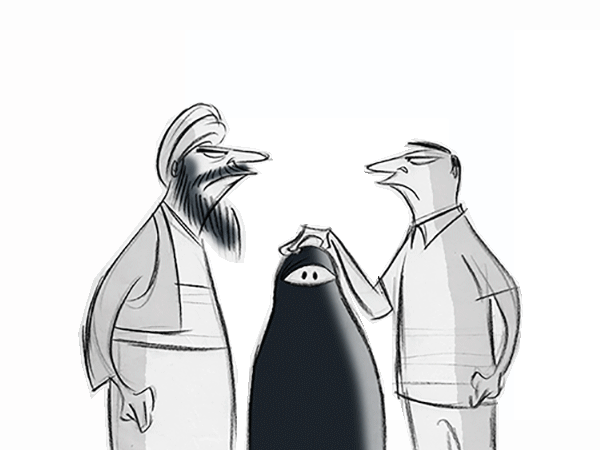
The 2016 New Year’s Eve celebrations in the German city of Cologne were overshadowed by an appalling series of sexual assaults. Newspapers and televisions screens were quickly filled with reports of sexual attacks committed by men of North African descent, apparently in the hundreds if not in the thousands. It was clear that a definitive turning point had been reached. Initial reports offered contradictory accounts and have since been qualified, but police statements confirmed that more than 1000 complaints were registered, 40-50% of which were offences of a sexual nature and the majority of the 59 identified suspects were indeed asylum seekers from Algeria, Morocco, Tunisia and Iraq.
Europe’s ‘long summer of migration’ of 2015 had seen the emergence of what was termed Willkommenskultur (‘welcoming culture’ towards migrants in Germany and Austria). Such celebrations now seemed distinctly premature. Other cases of molestation and rape involving asylum seekers followed. Enough to cause news outlets, tabloids and social media to go into a frenzy. Details of such crimes quickly got lost, fact mixed with fiction, and if headlines are to be believed, thousands of male migrants were now roaming the streets of European cities preying on women. Actual crime statistics may not support any such nightmarish visions, but the damage seems to have been done. Public outrage was aimed not only at the perpetrators, but at the entire ‘collective’ of migrants they were made to stand in for. Never mind that such a collective does not exist. Headlines quickly gave way to a blanket demonisation of those arriving at European borders. What followed were attacks on refugee centres, racist hate speech and politicians using real and fabricated crimes for their own political gain.
In the meantime anti-immigration crusaders have revealed themselves as not only as experts on Middle Eastern cultures and Islam, but also as committed feminists. Their expert assessments might not be especially well-informed, but what they lack in actual understanding, they make up for in sheer volume. While Islam was loudly decried a religion of molesters, the European far right – not exactly known for their commitment to gender equality and women’s rights – now appointed themselves the protectors of ‘their’ (i.e. European white) women against an ‘onslaught of Muslim rapists’.
Surely, now all those ‘leftist feminists’ had to concede that their call to accommodate refugees and other migrants had been a misstep with disastrous repercussions. Thousands of sexual aggressors simply could not be accepted into Europe; this, after all, we owed to ‘our’ women. Any nagging sense of guilt at having worsened or done nothing to alleviate the suffering of others was conveniently expunged, rationalised away. There is nothing more versatile than women’s bodies to justify all manners of crimes.
The events in Cologne were, no doubt, serious offences, but their aftermath proves how women come to be used as embodied justifications to agitate against refugees, migrants and religious minorities, with little regard for the victim’s experience.
The ways in which migrants are depersonalised on television screens and in newspapers have become increasingly crude. Media and politicians use metaphors that evoke the animalistic and the primitive. They speak of hordes of men from Arabic countries flocking together to pounce on women. With the resurgence of right wing populism feeding off of fantasies of re-empowerment, racism and its jarring language of escalation find resonance with audiences.

Very few editors stand against such commercial allure. The eerie efficiency of such depictions draws on a longstanding practice of objectifying ‘the Other’ through a narrative of sexualisation: The portrayal of white European femininity threatened by the overly sexualised and uncivilised ‘black man’ is routinely excavated from its colonial history, rehashed and re-audited for contemporary mass consumption.
The racist archetype of the North African sexual perpetrator, as he is staged in the theatres of mass media, links sexual violence exclusively with aberrant cultural difference. Rape is thereby culturalised, not in a way that would allow a careful consideration of its enabling structures, or a discussion of co-existing rape cultures in Europe, but in a way that declares patriarchal and sexist practices as an outside import and a defining attribute of the foreign. The fortification of European borders is accompanied by such imaginary borders, a cordon sanitaire warding off the spread of sexism and sexual violence to the supposedly enlightened and gender-equal North.
The fact is that most rape cases in Europe are, of course, still committed not by newly arrived migrants, but by European men known to their victims. After the events of Cologne, feminists also pointed out that incidents of harassment and rape also spike at events such as the Oktoberfest or big football games, pointing at a link between molestation and large groups of men consuming alcohol in public. Any effort to point out that sexual violence is alive and well in Europe with or without migrants is promptly met with accusations of downplaying crimes committed by refugees. Certainly there is no need to draw strained comparisons, but the disproportionate coverage the different forms of violence receive seems far from coincidental.
We will, of course, need to attend to the specificities of the attacks in Cologne. To argue that any reference to the perpetrators’ backgrounds would amount to racial profiling disregards the way sexual violence is embedded in social structures. This project will inevitably necessitate a look into the different gender politics in Arabic and North African states.
We know that Western sexual politics practice exclusion in their own institutionalised and more commodified ways. Yet, to gloss over the problems of structural sexism in other societies would ultimately amount to just another expression of a postcolonial superiority complex, one that would ultimately dismiss the numerous demands made by individual women and women’s movements within these countries and their migrant communities. Since we live in times of a global rise of Islamophobia, we may also need to explicitly acknowledge that these are not crimes sanctioned by any imaginary Muslim council.
Any real commitment to women’s wellbeing would also have to address the way Europe’s policies are purposefully designed to keep refugees at society’s margins. They thereby play a big role in criminalising young migrants. Young male migrants are often isolated in secluded refugee homes and offered little hope for the future. Economic refugees – those arriving from countries other than recognised political emergency zones such as Syria – face little chance of a positive asylum outcome. They remain in a liminal state with no right to work, but under significant pressure to send money to relatives back home. A substantial number of young migrants have themselves been subjected to sexualised violence. Many are reportedly trafficked into prostitution, or actively turn to prostitution for a lack of other options to earn money.
Sadly, built-up frustration has to be factored into criminal behaviour. If not for the sake of human decency and the protection of migrants, then at the very least the prevention of violence should prompt us to expand the rights of refugees, rather than to further restrict them. This would include spreading out living spaces across cities, enabling increased access to work and education, as well as granting the crucial right to family reunion. New circumstances brought about by mass migration should usher in a demand for inclusive rights and laws to protect all women, men and children residing in Europe, including the right to be held accountable for crimes according to the law instead of facing the threat of deportation.
An actual feminist perspective can, moreover, help draw attention to the female experience of migration, how women are further victimised by the closure of escape routes, or the particular hurdles they face in the asylum process. It can also speak to the way the image of Europe as overrun by Islam produces Muslims living in Europe as the ‘enemy within’. As attacks on Muslim women are on the rise, the kind of feminism used as subterfuge to sanction racism and exclusion has little to say about these issues. Indeed, it forms part of its self-righteous argument, as the resurfaced burqa and burkini debate prove. Under the pretext of concern for ever elusive and oppressed Muslim women, their access to public spaces is further curtailed and Muslim communities thereby ostracized. Instead of letting racism enter through this contraption, it has become clear that we need a kind of feminism, a feminism that actively resists being co-opted by logics of the state; that expressly reiterates its commitment to anti-racism, and refrains from brashly speaking over those who are capable and willing to speak for themselves.

After the events in Cologne, Syrian migrants took it upon themselves to distribute flyers explaining that Syrian culture does not in fact endorse the molestation of women. The systemically marginalised apparently need to prove their humanity in a desperate attempt to evade racist attacks. It was likely ineffective. Migrants are allowed little more than violence, disorder and backwardness to define them. As the media acquaints us with the monstrous figure of the foreign rapist wreaking havoc in European cities, he takes his place among what anthropologist Allen Feldman calls “virtual figures of disorder”[1]. The Muslim terrorist or the wounded child pulled from the rubble, they all emerge for a brief interlude before retreating into landscapes of violence and suffering that confirm their place outside of European modernity.
There are still initiatives that counteract this pervasive depersonalisation. There are commitments that new neighbours make to each other in the shared realm of everyday life. They prove that the often-cited incompatibility of different values, especially around women’s rights, does not speak of any real concern for issues of integration. It’s little more than a conceit, an artifice used deliberately to erect a polarised front between the Western liberal society and its moral inversion: the Islamic society as a static repository of sexism, violence and oppression.
Yet, we need only follow the coordinates set out by European fortification and its ensuing politics – its destitute refugee camps, the unconscionable ‘Turkey solution’, the desire to ‘off-shore’ the refugee problem, and lastly, the Mediterranean Sea as a mass grave – to know that the moral principles of human dignity and bodily autonomy Europe prides itself with come with harsh preconditions attached.
[1] “Memory Theaters, Virtual Witnessing and the Trauma Aesthetic.” Biography an Interdisciplinary Quarterly, 27 Winter, 2004 Allen Feldman
Cover image from Youtube